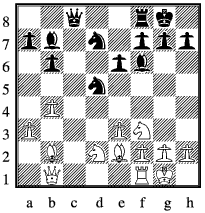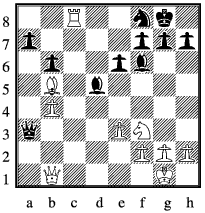
September 2016
When trying to identify the reason for a loss, it often comes down to an unprotected piece. Indeed many blunders come into this category when opponent springs a fork on you. Equally frequently when playing a stronger opponent it seems that all their pieces are protected even before you find a way of attacking them. Most frustrating.
To the game, which we join after 10 uneventful moves, with RR, white, about to choose his 11th.

|
| RR v Mike Hancock after 10 ... Bb7 |
There really is nothing better to do here than castles, but in the same way that enenmy rook on same file as my queen makes me nervous, so does having a pair of enemy knights too close. Admittedly that normally means in my half the board, but I decided to indulge in a little game of kick the knight anyway.
11 d4 Nd7, 12 Nbd2 c5, 13 dxc5 Nxc5, 14 b4 Nd7
15 Rc1 Rc8, 16 Qb1 Bf6, 17 Rxc8 Qxc8, 18 0-0

|
| RR v Mike Hancock after 18 0-0 |
Mike does indeed play Nc3:
Now time for a think. Rc1 looks natural, with black taking the a-pawn. (OK, black doesn't have to take the pawn, but
20 Rc1 Qb2, 21 Qxb2 Bxb2, 22 Rc7 and black's a-pawn disappears, so I assume this is not a line he would select). I don't want to lose a pawn, so how about Nc4 first, then Rc1. In fact the queen is now trapped. Yippee. But black has
20 Nc4 Bxf3, 21 Rc1 Be4 and white has nothing better than exchanging the queens to be a piece down. Other 21st moves are OK for white, but don't trap the queen. So Rc1 first.
20 Rc1 Qxa3 The fork Rc7 is tempting, but rather than the grovelling Bc8 black can take on f3. Besides I rather like trying to take advantage of his queens lack of squares - just a4 left at the moment.
21 Bb5 forking the white queens only flight square and the loose knight. Because of the latter black can't simply play Qb2 with intent to exchange queens.
21 ... Rc8, 22 Nc4 Rxc4, 23 Rxc4 Bd5, 24 Rc8+ Nf8

|
| RR v Mike Hancock after 24 ... Nf8 |
25 Nd2 Greedy. Nd4 prevents Bc3, but fortunately Mike was more concenred about creating an escape square for his king.
25 ... g6, 26 Nc4 Bxc4, 27 Rxc4 pleased to have broken the bishop pair.
27 ... a6, 28 Be8 Be7, 29 Rc7 Bxb4, 30 Bxf7+ Kh8
31 g3 Bd6, 32 Bb7 b5, 33 Qe4 Qa1+, 34 Kg2 Qc1, 35 Qd4+ 1-0
Cause of death? That loose knight on d7, coupled with failure to play Bxf3 before Qxc3 (recapture reflex?) which would have fatally slowed the threats to trap the black queen. A fortuitous win for RR perhaps, but he took advantage once the opportunity arose, even if 25 Nd2 attempted to give black a chance.
comment on this article